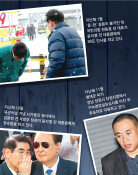Where Should Real Patients of SARS Go?
Where Should Real Patients of SARS Go?
Posted April. 25, 2003 22:19,
In order to prepare for increase in the number of SARS (Severe Acute Respiratory Syndrome) patients, Seoul designated Dongboo public hospital to be the major treatment center for SARS patients. Seoul city decided that securing the greatest possible number of sickbeds for treatment of SARS patients would be desperately needed. However, the administrative deputy mayor of Seoul city Cheong Du-eon told the residents of the area that “the designation had been cancelled.” Area residents previously had demonstrated in objection to the fact that one of its hospitals was going to be set aside for SARS patients.
This decision for cancellation was made abruptly because of strong objection from the residents, even though some suspected patients were already moved to another hospital. This was after Seoul city had reported to the National Institute of Health that Dongboo public hospital be the designated treatment hospital for SARS patients on April 23.
After the announcement at 5 p.m. on April 24, some 500 residents from the area unlawfully blocked the entrance to the hospital. Even after the announcement of cancellation of designation, some of the residents still continued demonstrating saying, “We cannot believe it.”
553 students, 53% of the 1,040 total students at Yongdoo elementary school located 30 meters away from the hospital, didn’t go to school on April 25, and all classes were cancelled at about 11 o`clock. Dongboo public hospital is currently not operating regularly because 35 of the 59 existing patients were moved to another hospital.
“We originally planned to designate Dongboo public hospital because the hospital had many spare sickbeds and modern equipment such as micro X-ray machines. But we gave it up due to strong objection from residents,” said Park Min-su, chief of the Health Department of Seoul. “No proper place has been designated other than Dongboo public hospital.”
“We haven`t received the formal report for cancellation regarding SARS hospital designation from Seoul city,” said an NIH official. “We will prepare 200 spare sickbeds by additionally designating isolated sickbeds in national hospitals, public hospitals and university hospitals, if the designation is officially cancelled.”
However, the capacity of holding more patients is limited because 13 patients as of April 25 who reported symptoms of SARS or suspected cases are already fully occupying the designated isolation hospital.
Problems are being seen as local residents oppose the use of national or public hospitals, and university hospitals are refusing to admit SARS patients.
“For the public hospitals like local medical centers, there also will be a rejection from local residents,” said a person in charge at the National Institute of Health. “In case that there is a large number of suspected patients, the use of military hospitals will be the last choice.”
One internal medicine professor at S hospital in Seoul commented: “Residents` objections are based on incorrect information. We need to recognize that everyone in the country will be a victim of SARS, and as a result, damage to the residents themselves will be far increased if they do not cooperate with authorities on SARS management.”
One man and one woman in their twenties who returned from Beijing and Shanghai, China showed symptoms of fever and difficulty breathing. They were added to the already growing number of Korean cases of SARS. As such, the number of suspected SARS cases in Korea has now increased to 10.
The Korean Red Cross accepted classification of dangerous places by the NIH, and made a decision not to receive blood donations for two weeks from people who traveled to any part of China including Hong Kong, Naimeong, Singapore, Hanoi, and Toronto.
leej@donga.com egija@donga.com
Headline News
- Ruling, opposition parties to set up their election committees
- Financial authorities set to support auto industry
- LG's Arizona plant to produce cylindrical batteries from next year
- Yoon removed from office by unanimous court decision
- Constitutional Court mentions responsibility of both Yoon and National Assembly







